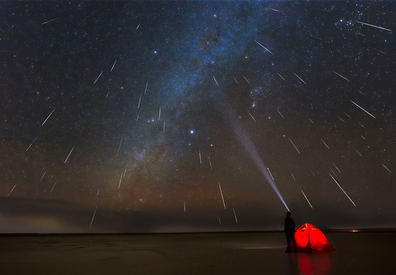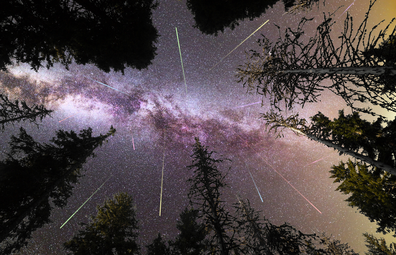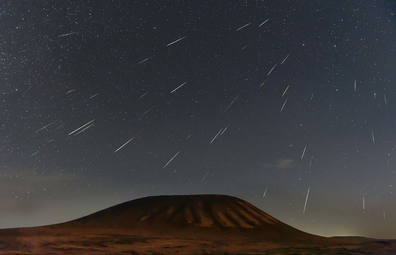Geminids meteor shower 2019: where to view the 'King of Showers' in Australia
By Katherine Scott|
Star gazers and space geeks are bracing for one of the year's biggest astronomical events, as the annual fiery Geminids meteor shower gets set to light up our skies with multi-coloured shooting stars on December 14 and 15 in Australia.
What is the Geminids meteor shower?
For Aussies setting their alarm clocks to catch the Sunday peak viewing time of 5.40am (AEDT), you're in for a treat, according to Macquarie University's astrophysicist Dr Tayyaba Zafar.
"Geminids is a significant meteor shower with the highest number of meteors per hour (100-150), therefore, called the King of Showers," Dr Tayyaba tells 9Honey.
Although the parents of meteor showers are usually comets, a Geminids shower is unique.
"Unlike other meteor showers, the parent of Geminids is an asteroid, 3200 Phaethon – a rocky asteroid."
What's also interesting about this spectacle, is the rainbow effect it's known to produce.
"Geminids are slow moving meteors, vary from faint to very bright, and are multi-coloured depending on the composition of different meteorites."

When is the Geminids Meteor Shower?
The spectacle will run over December 14 and 15, but the time will vary depending on which city you live in. For Sydneysiders, the sky show will kick off on Saturday December 14 around 11pm (AEDT), with peak viewing on Sunday, December 15 at 5.40am (AEDT).
Melbourne / Canberra / Sydney (AEDT)
Begins: December 14, 11pm
Peak viewing: December 15, 5.40am
Brisbane (AEST)
Begins: December 14, 10pm
Peak viewing: December 15, 4.40am
Darwin (ACST)
Begins: December 14, 9.30pm
Peak viewing: December 15, 3am
Perth (AWST)
Begins: December 14, 8pm
Peak viewing: December 15, 1.30am
Adelaide (ACDT)
Begins: December 14, 10.30pm
Peak viewing: December 15, 4am
You can track the Geminids in Sydney at timeanddate.com.
How long will it last?
The shooting star extravaganza will be visible for around seven hours, depending on conditions and cloud coverage, but peak viewing time will occur early on Sunday morning (refer to times above for your city/timezone).

When will it happen again?
If you don't catch it this year, the good news is that this spectacle is an annual event.
The Geminids' mother asteroid, 3200 Phaethon, passes close to the earth at a safe distance in an elongated path around the sun every 524 earth days.
"This asteroid might have had a collision with some objects in the past, which produced a stream of particles, and the Earth runs through this debris every year, so this shower happens every year," Dr Tayyaba says.
"Next year will be from December 4 to 17 again, with peak on December 14th, 2020."
Best time for viewing
In Australia, the show will happen between the nights of Saturday 14 and Sunday 15 December 2019.
The meteors will radiate from northern horizon near the bright star Castor in the Gemini constellation but will appear anywhere in the sky. All you need is your bare eyes.
Best location for viewing
"The great thing about this shower is that its visible from both hemispheres," Dr Tayyaba says
But while it's visible across the world, some destinations have a better vantage point than others.
In Australia, those based in the northern-most states will get the best view.
"The more in the north [you are] the better. So from an Australian perspective, Darwin is best vantage point, and Hobart will the least ideal."
To further enhance your viewing, Dr Tayyaba says to head away from light pollution and find a spot with unobstructed views, like a national park.
"It will be a great night of star gazing, so for the best view head away from the city lights."
What will happen?
More than 100 multi-coloured meteors will shoot across the sky each hour at its peak, but they're slow-moving meteors, with a speed of 20-35km/s.
On the weekend of the big event, we're set to have a full moon, and experts warn that this may affect the quality of the viewing.
"It will be full moon during the shower period making the faint meteors to be washed out this year.
"Still abundant bright meteors – 20-40 per hour – will be produced, making a good show through the glare of the full moon."

What should people look out for?
In NSW, the radiant will rise well before midnight giving stargazers the rest of the night to enjoy the prolific fiery performance, with the best viewing any time after midnight.
The meteors will radiate from the northern horizon near the bright star Castor in the Gemini constellation but will appear anywhere in the sky.
"The meteors are Geminids, slow-moving meteors with a speed of 20-35km. It will be a great night of star gazing so for the best view head away from the city lights," says Dr Tayyaba.
Any special equipment needed (i.e. telescope?)?
Due to the scale of the meteor shower and the type of meteors, you won't need any special equipment to view the spectacle, according to Dr Tayyaba.
"The interesting thing about these shooting stars is that you do not need binoculars or a telescope given the scale of the meteor shower and the type of meteors. All you need is to give your eyes about 30 minutes to adjust to the night sky."
Why is it called the Geminids meteor shower?
The origin of Geminids derives from Gemini – that's the constellation, Gemini, not the zodiac sign. The Gemini constellation is governed by its two brightest stars, Castor and Pollux, and are often visible throughout the northern winter months, from mid-December to early January.
Fun fact: Gemini is Latin for "twins", associated with the twins Castor and Pollux in ancient Greek mythology.
Read more from Dr Tayyaba Zafar on why this year's Geminids spectacle is not to be missed.


